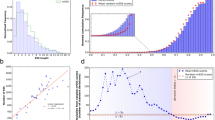Abstract
A gene-specific, metagenomic PCR method has led to the discovery of a novel esterase subfamily consisting of five homologous members. Sequence analysis of this esterase subfamily, named the ArmEst subfamily, revealed a unique conserved pattern with a significant variable interior sequence flanked by two symmetric and identical long arm sequences. The two homologous long arm sequences had 100 % sequence identity and symmetry at both ends between the five members of this esterase class, but only 17–58 % identity was shared for the internal sequence. The biochemical properties of two of the ArmEst esterases definitively demonstrated that they are true active esterases rather than pseudogenes. This is the first report presenting an esterase subfamily containing a unique arm sequence, indicating a rare homologous recombination occurring in the coding area of a functional gene to generate their functional diversity.




Similar content being viewed by others
References
Arpigny JL, Jaeger KE (1999) Bacterial lipolytic enzymes: classification and properties. Biochem J 343:177
Bornscheuer UT (2006) Microbial carboxyl esterases: classification, properties and application in biocatalysis. FEMS Microbiol Rev 26:73–81
Charbonneau DM, Meddeb-Mouelhi F, Beauregard M (2010) A novel thermostable carboxylesterase from Geobacillus thermodenitrificans: evidence for a new carboxylesterase family. J Biochem 148:299–308
Cheng Q, Campbell E, Naughton A, Johnson S, Masure H (1997) The com locus controls genetic transformation in Streptococcus pneumoniae. Mol Microbiol 23:683–692
Ewis HE, Abdelal AT, Lu CD (2004) Molecular cloning and characterization of two thermostable carboxyl esterases from Geobacillus stearothermophilus. Gene 329:187–195
Handelsman J, Rondon MR, Brady SF, Clardy J, Goodman RM (1998) Molecular biological access to the chemistry of unknown soil microbes: a new frontier for natural products. Chem Biol 5:R245–R249
Heath C, Hu XP, Cary SC, Cowan D (2009) Identification of a novel alkaliphilic esterase active at low temperatures by screening a metagenomic library from Antarctic desert soil. Appl Environ Microbiol 75:4657–4659
Hemilä H, Koivula TT, Palva I (1994) Hormone-sensitive lipase is closely related to several bacterial proteins, and distantly related to acetylcholinesterase and lipoprotein lipase: identification of a superfamily of esterases and lipases. Biochim Biophys Acta 1210:249–253
Hemingway J, Ranson H (2000) Insecticide resistance in insect vectors of human disease. Annu Rev Entomol 45:371–391
Iqbal HA, Feng Z, Brady SF (2012) Biocatalysts and small molecule products from metagenomic studies. Curr Opin Chem Bio 16:109–116
Kakirde KS, Parsley LC, Liles MR (2010) Size does matter: application-driven approaches for soil metagenomics. Soil Biol Biochem 42:1911–1923
Kim YH, Kwon EJ, Kim SK, Jeong YS, Kim J, Yun HD, Kim H (2010) Molecular cloning and characterization of a novel family VIII alkaline esterase from a compost metagenomic library. Biochem Biophys Res Commun 393:45–49
Kotik M (2009) Novel genes retrieved from environmental DNA by polymerase chain reaction: current genome-walking techniques for future metagenome applications. J Biotechnol 144:75–82
Larkin M, Blackshields G, Brown N, Chenna R, McGettigan P, McWilliam H, Valentin F, Wallace I, Wilm A, Lopez R (2007) Clustal W and Clustal X version 2.0. Bioinformatics 23:2947–2948
Lee MH, Lee CH, Oh TK, Song JK, Yoon JH (2006) Isolation and characterization of a novel lipase from a metagenomic library of tidal flat sediments: evidence for a new family of bacterial lipases. Appl Environ Microbiol 72:7406–7409
Lee LC, Chen YT, Yen CC, Chiang TCY, Tang SJ, Lee GC, Shaw JF (2007) Altering the substrate specificity of Candida rugosa LIP4 by engineering the substrate-binding sites. J Agric Food Chem 55:5103–5108
Liebeton K, Eck J (2004) Identification and expression in E. coli of novel nitrile hydratases from the metagenome. Eng Life Sci 4:557–562
Santoyo G, Romero D (2005) Gene conversion and concerted evolution in bacterial genomes. FEMS Microbiol Rev 29:169–183
Schmeisser C, Steele H, Streit WR (2007) Metagenomics, biotechnology with non-culturable microbes. Appl Microbiol Biotechnol 75:955–962
Schmidt M, Bornscheuer UT (2005) High-throughput assays for lipases and esterases. Biomol Eng 22:51–56
Simon C, Daniel R (2011) Metagenomic analyses: past and future trends. Appl Environ Microbiol 77:1153–1161
Sjöling S, Cowan DA (2008) Metagenomics: microbial community genomes revealed. In: Margesin R, Schinner F, Marx JC, Gerday C (eds) Psychrophiles: from biodiversity to biotechnology. Springer-Verlag, Berlin, pp 313–332
Tamura K, Dudley J, Nei M, Kumar S (2007) MEGA4: molecular evolutionary genetics analysis (MEGA) software version 4.0. Mol Biol Evol 24:1596–1599
Upton C, Buckley JT (1995) A new family of lipolytic enzymes? Trends Biochem Sci 20:178–179
Wang Q, Wu H, Wang A, Du P, Pei X, Li H, Yin X, Huang L, Xiong X (2010) Prospecting metagenomic enzyme subfamily genes for DNA family shuffling by a novel PCR-based approach. J Biol Chem 285:41509–41516
Xiong X, Yin X, Pei X, Jin P, Zhang A, Li Y, Gong W, Wang Q (2012) Retrieval of glycoside hydrolase family 9 cellulase genes from environmental DNA by metagenomic gene specific multi-primer PCR. Biotechnol Lett 34(5):875–882
Acknowledgments
This work was supported by National Natural Science Foundation of China (30900253, 21006018, 21206024), Zhejiang Provincial Natural Science Foundation of China (LY13C050004, LQ12B06007). Technology Research and Development Program of Hangzhou (20092113A03, 20101131N03).
Author information
Authors and Affiliations
Corresponding author
Rights and permissions
About this article
Cite this article
Zhang, A., Zhao, R., Jin, P. et al. Discovery of a novel esterase subfamily sharing an identified arm sequence (ArmEst) by gene-specific metagenomic PCR. Biotechnol Lett 35, 1937–1944 (2013). https://doi.org/10.1007/s10529-013-1293-4
Received:
Accepted:
Published:
Issue Date:
DOI: https://doi.org/10.1007/s10529-013-1293-4




